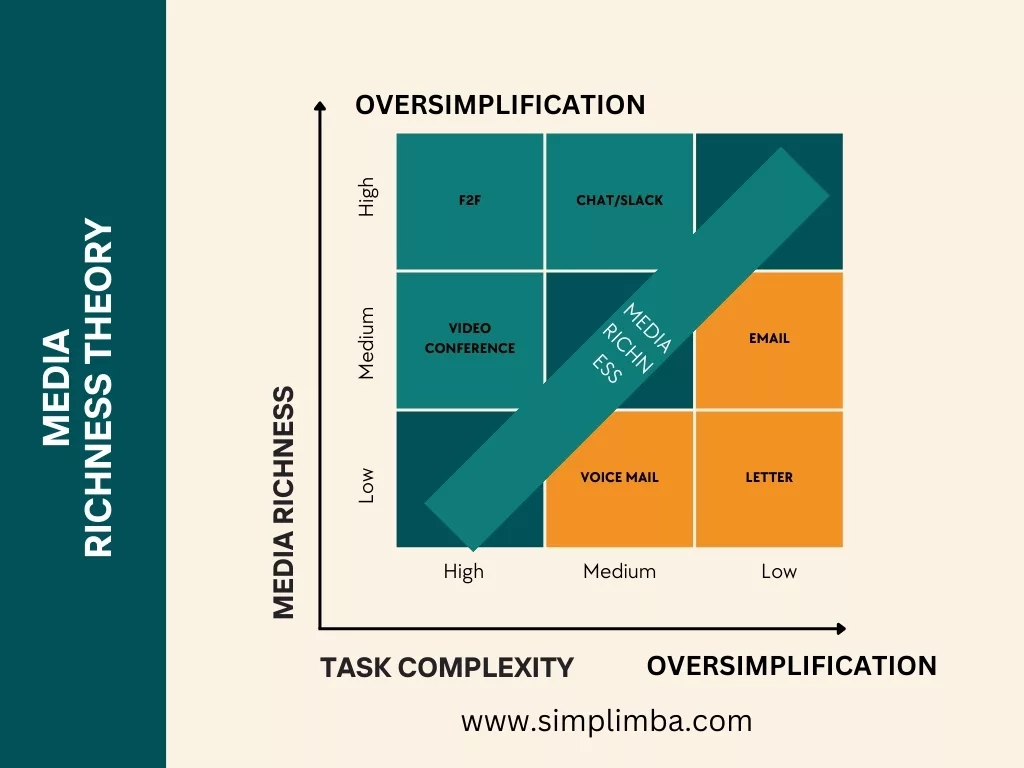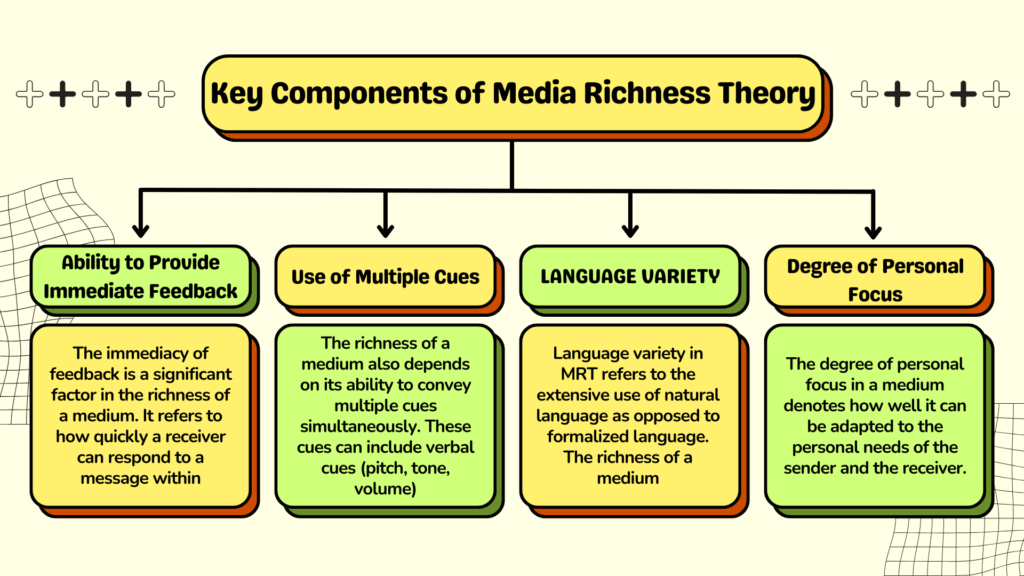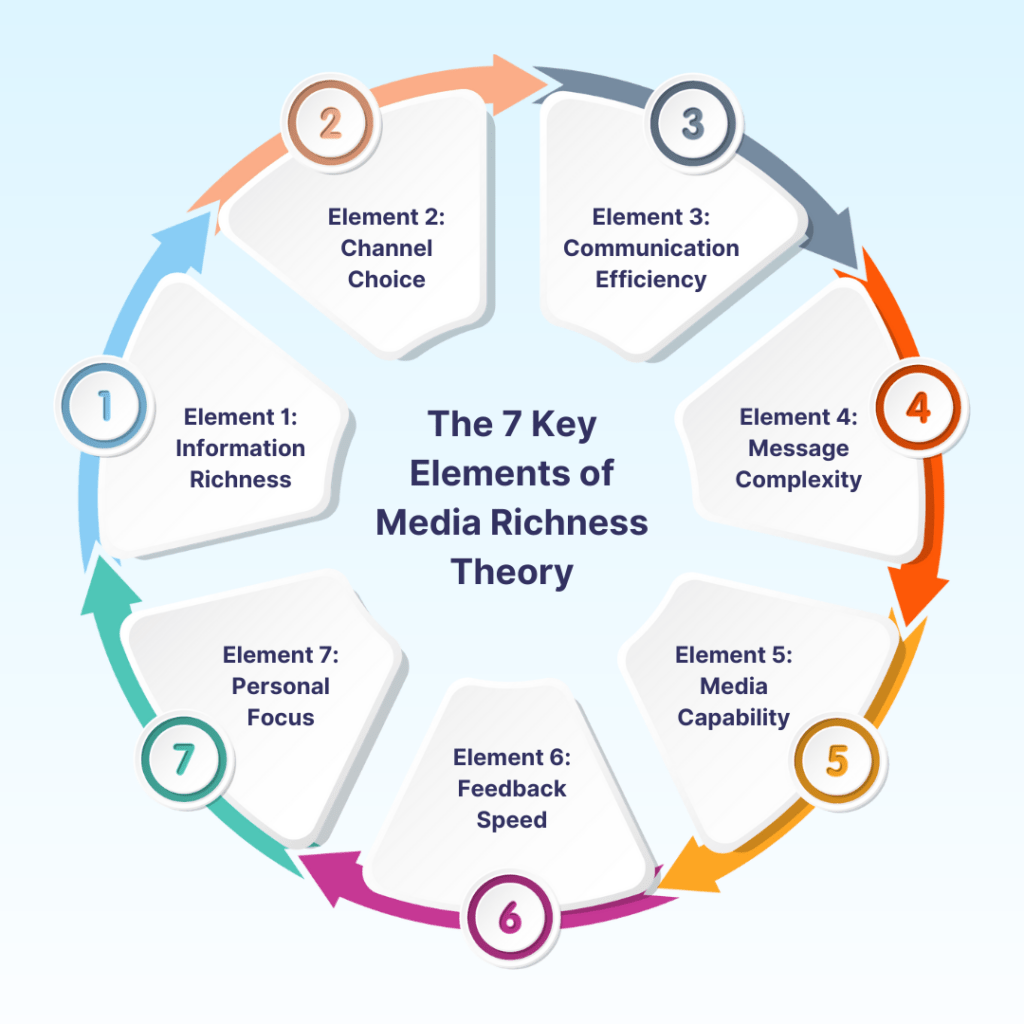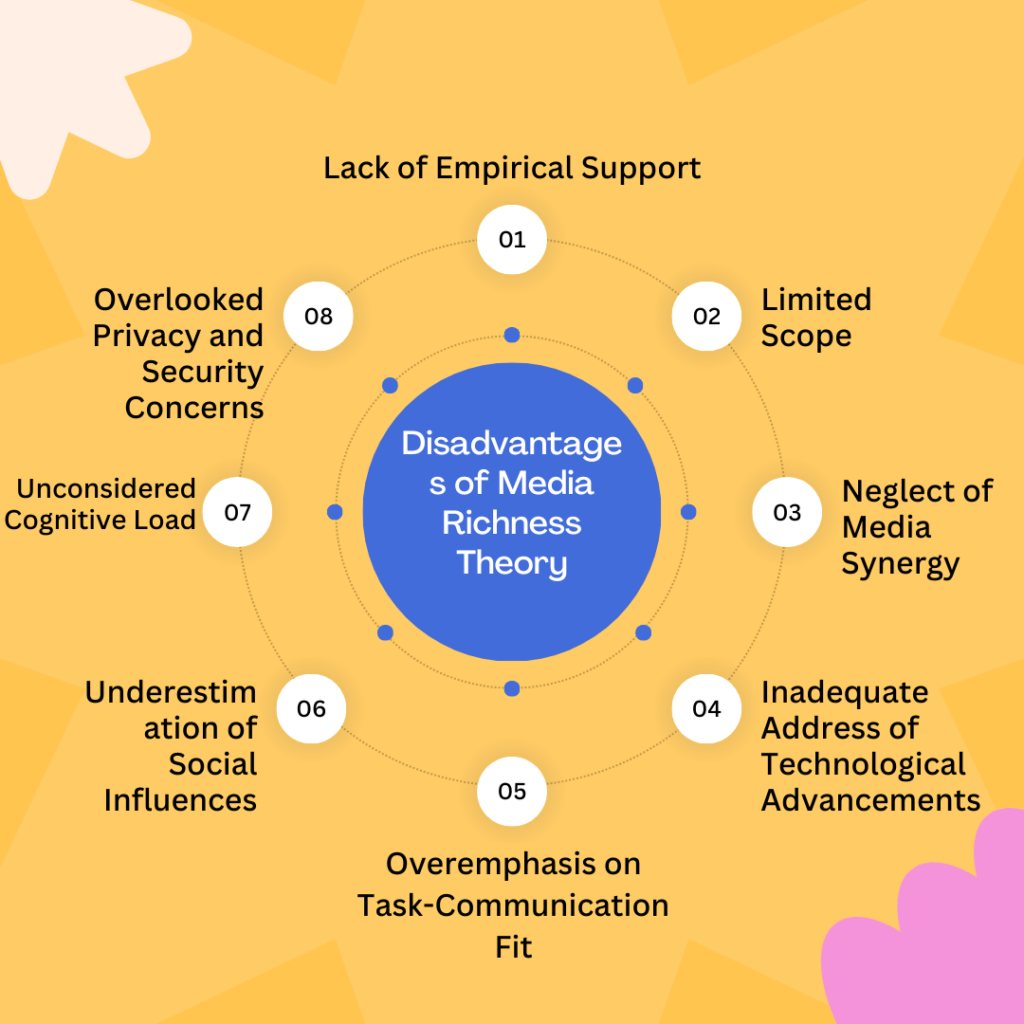Brief overview of Media Richness Theory
Media Richness Theory (MRT), first introduced by Richard L. Daft and Robert H. Lengel in 1986, is a framework used to describe a communication medium’s ability to reproduce the information sent over it. It suggests that more complex and ambiguous tasks require richer forms of media, characterized by the capacity for immediate feedback, multiple cues (such as voice, and body language), personal focus, and language variety.
The theory classifies different communication mediums, ranging from rich mediums like face-to-face meetings and telephone conversations to leaner mediums, such as e-mails and letters. The richness or leanness of a medium depends on four factors: the medium’s capacity for immediate feedback; the number of cues and channels available; language variety; and the degree to which intent can be focused on the recipient.
The theory posits that richer mediums, such as face-to-face communication, are better suited for more complex tasks, as they can provide immediate feedback, present multiple cues (like voice inflection, body language), and use natural language. On the other hand, leaner mediums, such as emails or memos, are best suited for simpler tasks.

Key Components of Media Richness Theory
The Four Criteria: According to MRT, the richness of a medium is determined by four elements: the ability to provide immediate feedback; the use of multiple cues; language variety; and the degree of personal focus. Let’s delve deeper into each of these four elements that determine the richness of a medium according to the Media Richness Theory (MRT).

Ability to Provide Immediate Feedback
The immediacy of feedback is a significant factor in the richness of a medium. It refers to how quickly a receiver can respond to a message within a communication medium. Immediate feedback allows for real-time clarification, making the communication process more efficient and decreasing the likelihood of misunderstanding. For example, mediums like face-to-face conversation, telephonic conversation, or video conferencing allow for immediate feedback as communication is instantaneous. On the other hand, emails or letters might not provide immediate feedback as there is often a delay between the sender transmitting the message and the receiver responding to it.
Use of Multiple Cues
The richness of a medium also depends on its ability to convey multiple cues simultaneously. These cues can include verbal cues (pitch, tone, volume), non-verbal cues (facial expressions, body language), and language cues (jargon, slang, vocabulary). A medium that allows multiple cues simultaneously is considered richer as it provides more contextual information. For instance, video conferencing allows individuals to use body language, facial expressions, tone of voice, and language, making it a richer medium compared to an email or a letter which primarily relies on language cues.
Language Variety
Language variety in MRT refers to the extensive use of natural language as opposed to formalized language. The richness of a medium increases if it allows for the use of informal, expressive, and nuanced language. Natural language, which includes colloquialisms, idioms, and other non-standard forms of language, can convey more meaning and emotional content than formalized language, which tends to be more structured and rule-bound. A face-to-face conversation, which offers a wide variety of language usage, is considered richer than a formal report, which limits the language variety.
Degree of Personal Focus
The degree of personal focus in a medium denotes how well it can be adapted to the personal needs of the sender and the receiver. A medium with a high degree of personal focus allows for customizing messages, which enhances the richness. This might include the ability to express emotions, use humor, or share personal anecdotes. Social media platforms, for instance, provide a high degree of personal focus as users can personalize their messages, making it a rich medium. In contrast, formal reports, which must adhere to a structured format, offer a lower degree of personal focus.
History and Evolution of Media Richness Theory
Origin: The Media Richness Theory was first introduced by organizational theorists Richard L. Daft and Robert H. Lengel in 1986. Their work was based on contingencies in an organizational environment, particularly the coordination and communication between team members.
Evolution: Over the years, the theory has transformed with the advent of new communication technologies. Initially, it was designed around traditional communication networks within organizations (like memos, reports, telephone, and face-to-face communication). Later developments expanded the theory to encompass digital communication mediums (like emails, instant messaging, and video conferencing).
Criticism and Re-evaluation: The theory has been subject to critique, primarily in terms of its ‘richness’ criteria and one-size-fits-all approach. In response, researchers have re-evaluated and modified the theory. One significant evolution is the introduction of the ‘Task-Media Fit’ concept, which proposes that the effectiveness of a medium depends on how well it fits the communication task at hand.
Current Relevance: Despite the critiques, Media Richness Theory remains a significant theoretical framework, guiding researchers and practitioners in their understanding of organizational communication. It has been instrumental in framing studies investigating the effectiveness of various communication mediums in different contexts.
The 7 Key Elements of Media Richness Theory

Element 1: Information Richness
Information richness is the depth and breadth of information that is transmitted via a communication channel. It pertains to the capacity of the media to effectively and accurately convey the intended information to the recipient. The richness of information may be determined by factors such as the use of multiple cues (visual, auditory, etc.), language variety, the extent of personalization and customization in the communication, and the immediacy of feedback. In essence, media that can handle high levels of ambiguity and uncertainty in information are considered richer.
Element 2: Channel Choice
Channel choice refers to the medium used to send and receive messages. This could range from face-to-face interactions, which are high in media richness, to the use of email or text messages, which may be lower in richness. The choice of channel depends on the nature of the message, the receiver’s preference, and the context of the communication. The more ambiguous and complex the information, the richer the media needs to be.
Element 3: Communication Efficiency
Communication efficiency concerns the speed, responsiveness, and cost-effectiveness of the chosen communication channel. Efficiency is crucial in situations where timely feedback is necessary. A highly efficient medium allows for instant feedback, while a less efficient medium may cause delays.
Element 4: Message Complexity
Message complexity relates to the difficulty involved in understanding the message. Complex messages often require a rich medium to ensure accurate comprehension. This is especially true when the message contains non-verbal cues, such as body language or tone of voice, which can add layers of meaning.
Element 5: Media Capability
Media capability refers to the functional capacities of different media channels. Some channels, like video conferencing, are capable of conveying complex and nuanced information through visual and auditory cues, making them richer. Others, like emails or instant messages, may be less capable in transmitting such details, but could still be effective for simpler, more straightforward communication.
Element 6: Feedback Speed
Feedback speed involves the rate at which the receiver can respond to the sender’s message. Faster feedback is generally associated with richer media, as it allows for instant clarification and reduces misunderstanding. The speed of feedback is particularly important in situations requiring immediate action or decision.
Element 7: Personal Focus
Personal focus is about the degree to which the communication medium allows for personal interaction and engagement. Richer media, like face-to-face conversations or video calls, allow for personal focus as they enable direct, two-way communication. On the other hand, leaner media like emails may be less personal, but they can still be effective depending on the situation and context.
Importance of Media Richness Theory in modern management and leadership
The role of the Media Richness Theory is more crucial than ever in modern management and leadership for several reasons.
Firstly, it aids in deciding the most effective communication mediums that can enhance decision-making, team performance, and knowledge management. For example, complex issues requiring an in-depth discussion may be better suited to richer mediums like face-to-face meetings or video conferences, while simpler tasks can be communicated effectively through leaner mediums such as emails or instant messaging.
Secondly, with the digital transformation in the workplace, understanding MRT can help leaders adapt to and implement new technologies effectively. It provides a framework to understand which tasks can be moved to digital communication channels and which require more traditional, richer communication methods.
Lastly, MRT can help address challenges related to remote work, a growing trend even before the Covid-19 pandemic. Leaders can use the theory to choose the appropriate level of media richness to maintain effective communication, build relationships, and foster a sense of belonging among remote teams.
Practical Applications of Media Richness Theory in Management
Enhancing Team Communication
Media Richness Theory (MRT) posits that the richness of a particular communication medium is determined by four dimensions: immediate feedback, multiple cues, language variety, and personal focus. By understanding these dimensions, management can significantly enhance team communication.
Immediate Feedback: Feedback is crucial in any team setting as it promotes learning and improvement. Tools such as online collaboration platforms facilitate real-time interaction, enabling immediate feedback and allowing teams to adapt quickly.
Multiple Cues: MRT suggests that rich media, which allow for multiple cues like voice tone, body language, and facial expressions, are more effective for complex communications. Management can leverage video conferencing tools to convey complex messages or emotions effectively.
Language Variety: Diverse teams may require media that support language variety. Management can use translation tools or multilingual platforms to ensure clear communication across different languages.
Personal Focus: Personalized communication can foster better relationships within teams. Management can achieve this by using media that allow personalized messages, like emails or direct messages.
Boosting Leadership Effectiveness
Leaders can leverage MRT to enhance their effectiveness in various ways.
Leaders can use rich media for complex or ambiguous tasks where they need to provide detailed instructions and immediate feedback.
Through the use of video conferencing tools, leaders can effectively convey non-verbal cues, fostering a better understanding of the information being communicated.
By utilizing media that support language variety, leaders can effectively communicate with diverse team members, fostering an inclusive work environment.
Leaders can leverage media that allow personal focus to build stronger relationships with their team, promote engagement, and build trust.
Optimizing Decision-Making Processes
MRT can be instrumental in optimizing decision-making processes in management.
Management can use rich media to provide comprehensive information, reducing uncertainty and ambiguity in decision-making processes.
Real-time collaborative tools can facilitate immediate feedback during decision-making sessions, promoting the exchange of ideas and enabling quicker consensus.
By using media that offer multiple cues, management can effectively convey complex information, facilitating more informed decision-making.
Media that support language variety can ensure that decision-making processes are inclusive, taking into consideration diverse perspectives.
Case Studies: Successful Implementation of Media Richness Theory
Case Study 1: Multi-National Corporation’s Adoption of Media Richness Theory
The first case study involves a multinational corporation (MNC) that integrated Media Richness Theory (MRT) into its internal communication strategies. This MNC had offices spread across various geographical locations, which often caused miscommunication and a lack of cohesion. To address these issues, they decided to classify their communication based on the levels of media richness required, ranging from face-to-face meetings to emails. High-richness media, like video conferences, were used for complex discussions, while low-richness media, like emails or memos, were utilized for straightforward, routine messages.
The implementation led to substantial improvements in communication quality. Misunderstandings decreased, as did the frequency of communication-related conflicts. The MNC reported a 20% increase in productivity rates post-implementation of MRT in their communication strategy.
Case Study 2: University’s Use of Media Richness Theory
Our second case study focuses on a university that implemented MRT in its teaching methodology. With the advent of online learning, the university found it challenging to communicate complex concepts effectively. They used MRT to determine the richness of media required for different learning contexts.
Lectures were recorded and shared through high-richness media, allowing students to revisit them for a better understanding. Discussion forums, a medium richness platform, facilitated intellectual exchanges among students, while emails, a low-richness media, were used for administrative communication. The university experienced a significant increase in student engagement and performance, with an average 15% rise in grades post-implementation.
Case Study 3: Healthcare Organization’s Application of Media Richness Theory
The third case study involves a healthcare institution that applied MRT to optimize patient care. The institution found that miscommunication often led to mistakes and lower patient satisfaction. They decided to implement MRT to determine the most appropriate communication medium based on the situation’s complexity.
High-richness media, like face-to-face conversations or video calls, were used for discussing complex diagnoses and treatment plans with patients. Medium-richness media, like phone calls, were utilized for follow-up conversations, and low-richness media, like SMS or emails, were used for appointment reminders and health tips. The healthcare organization reported a 30% improvement in patient satisfaction and a significant decrease in communication-related errors post-implementation.
Disadvantages of Media Richness Theory

Lack of Empirical Support: Despite its theoretical appeal, empirical support for MRT is mixed. Several research studies have failed to find the predicted relationships between media richness, uncertainty, and equivocality. Some researchers attribute this to the theory’s oversimplification of communication processes.
Limited Scope: MRT focuses on the “richness” of media, primarily based on its ability to provide immediate feedback, use multiple cues, use natural language, and have a personal focus. This emphasis on certain characteristics limits the scope of the theory and overlooks other potentially significant factors such as user skills, media access, and cultural aspects.
Neglect of Media Synergy: MRT places media on a continuum of richness, which assumes that media are mutually exclusive and substitutable. It neglects the potential for media synergy, where the combined use of different media could provide benefits beyond those of a single, richer medium.
Inadequate Address of Technological Advancements: With constant technological advancements, new media forms are constantly emerging, offering features that can enhance communication. MRT, being a theory developed years ago, may not be able to adequately address the capabilities and implications of these new media forms.
Overemphasis on Task-Communication Fit: MRT places great emphasis on the need to match the richness of the media with the task’s equivocality. However, it’s not always possible or practical to achieve a perfect task-media fit. Moreover, in many settings, people may not have the flexibility to choose their media, or they may base their choice on factors other than task equivocality.
Underestimation of Social Influences: MRT tends to overlook social influences in media selection and use. People’s media choices are often influenced by their social environment, including organizational norms, peer behavior, and social networks. Additionally, people often use media for social purposes, not just for task-related communication.
Unconsidered Cognitive Load: The theory does not consider the cognitive load that may be associated with media richness. As the richness increases, so does the amount of information that needs to be processed, potentially leading to cognitive overload.
Overlooked Privacy and Security Concerns: MRT does not account for privacy and security concerns related to media use. As media get richer, they often require more data transfer, opening up potential risks for information security and privacy.
Revisiting Media Richness Theory for today and the future
Common obstacles in applying Media Richness Theory
Technological Evolution: The most pronounced obstacle is the rapid advancement of technology. Daft and Lengel developed MRT before the advent of digital communication, so applying it to contemporary media can be challenging. The theory might not adequately address the characteristics, benefits, and drawbacks of modern communication tools like social media, virtual reality, or artificial intelligence.
Cultural Differences: MRT does not account for cultural differences in communication. Culture significantly influences how individuals perceive and use media richness. What is deemed ‘rich’ in one culture might not be perceived similarly in another. This cultural bias can restrict the global applicability of MRT.
Varying User Skills: The effectiveness of a medium depends on users’ skills and familiarity with the medium, which MRT doesn’t consider. Users adept at a specific medium may find it richer than those who aren’t.
Effective strategies to overcome these challenges
To enhance the applicability of MRT in the modern context, we need to adopt certain strategies.
Updating the Theory: The theory needs to be updated to include digital communication tools. It should consider different aspects of modern communication like interactivity, user-generated content, and multimodality. Methodological advancements in computational and network analysis can be incorporated to improve the theory’s comprehensiveness.
Including Cultural Factors: The theory should be expanded to account for cultural variations in media richness perception. Comparative studies across different cultures can shed light on these variations and help tailor the theory to diverse cultural contexts.
Considering User Skills: The theory should incorporate user skills and familiarity with the medium. Future studies could explore how user skills influence media richness perception and the effectiveness of communication.
The Relevance of the Theory for Future
Despite the challenges, MRT holds significant relevance for the future.
Digital Communication: As digital communication becomes increasingly prevalent, understanding media richness can help optimize communication strategies. MRT can guide the selection of suitable media for different communication tasks.
Artificial Intelligence (AI): MRT can help analyze the richness of AI-powered communication. It can guide the design of AI systems to enhance their communication effectiveness.
Remote Work: The surge in remote work due to COVID-19 has highlighted the importance of effective communication. MRT can provide valuable insights for enhancing communication in remote work settings.
Samrat is a Delhi-based MBA from the Indian Institute of Management. He is a Strategy, AI, and Marketing Enthusiast and passionately writes about core and emerging topics in Management studies. Reach out to his LinkedIn for a discussion or follow his Quora Page
